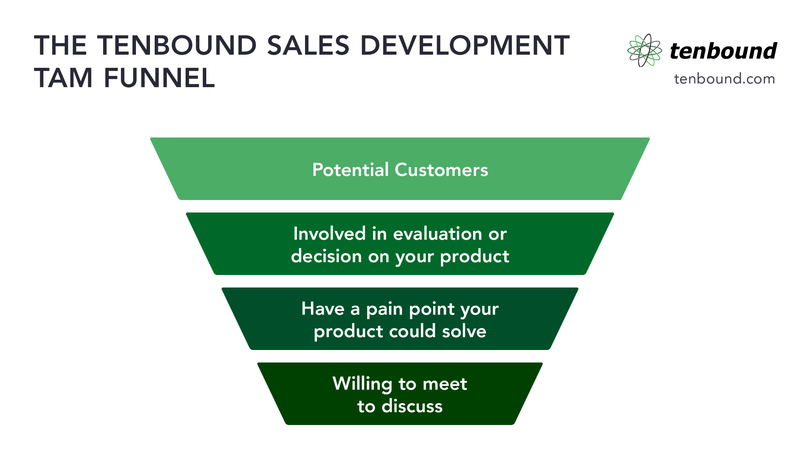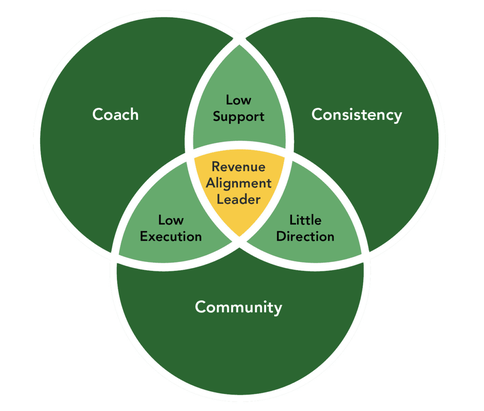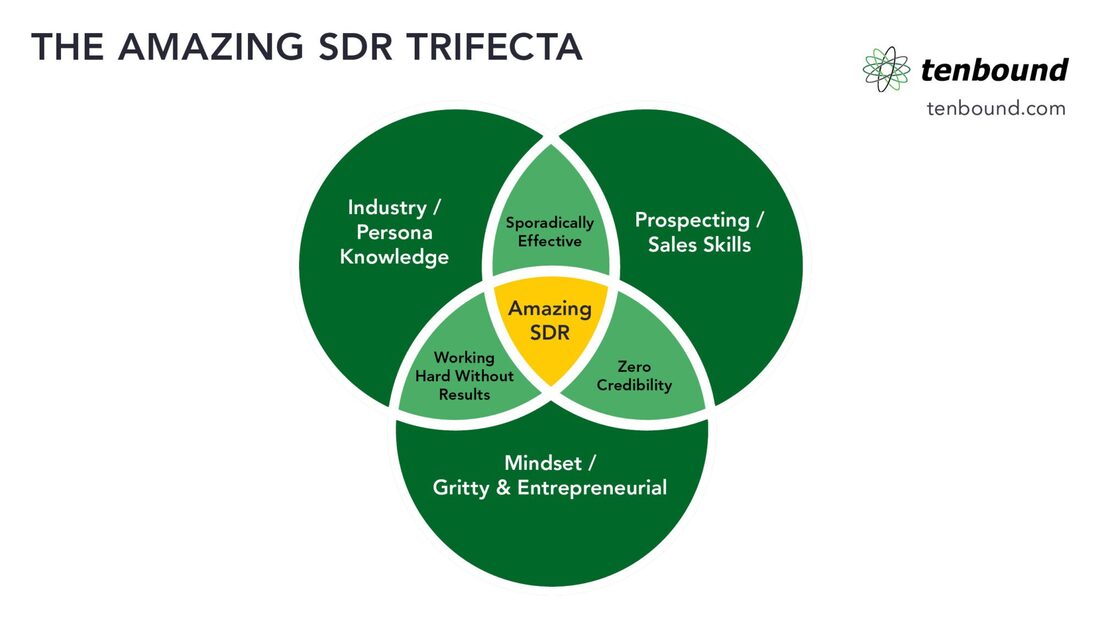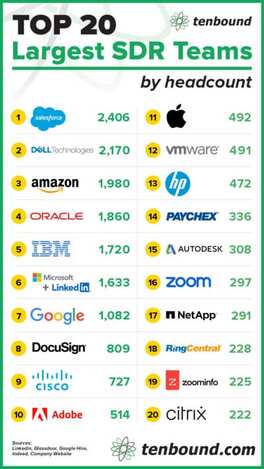Tenbound Announces BEAST Award Winners 2021
10/29/2021
Comments
Tenbound, a Research & Advisory firm focused 100% on Sales Development, announced the winners of this year’s BEAST Awards for excellence in Sales Development, at The Tenbound Sales Development Conference 2021 on October 27th, 2021 in San Francisco.
The BEAST Award is a voting award specifically for the Sales Development community, run each year in leading up the annual Conference. It includes four categories, with the highest number of unique votes winning in each category. The categories include Best Sales Development Team, Best Sales Development Technology, Best Sales Development Leader, and Best Sales Development Representative. Once again this year, Tenbound received a record number of votes in each category. David Dulany, Tenbound Founder & CEO stated: “Sales Development is growing in importance in B2B SaaS companies and in many other industries. The Tenbound BEAST Awards represent the best in the burgeoning Sales Development industry, the top-rated Leaders, Reps, Teams, and Technology out there performing at the highest level in our field. We are proud to be associated with all the nominees and winners!” The 2021 Winners: Best Sales Development Leader Patrick Jeter, Groove Best Sales Development Representative Alex Trca, LeadIQ Best Sales Development Team LeanData led by Rob Simmons Best Sales Development Technology Regie.ai led by Matt Millen CONGRATULATIONS to all our winners! This is the future of Sales Development. Sales Development used to be a numbers game. "Smile and Dial."
Make enough calls, knock on enough doors, send out enough emails, and eventually, you’d set an appointment. The arrival of the digital age changed the platforms, but not the overall strategy: send out enough emails, make enough cold calls, spend enough on ads, and eventually, you’d land an appointment. But as Sales Development teams grew and technology was created to support them, it unleashed a spam tsunami on the buyer community. If you could mass email ten people, you could just as easily mass email tens of thousands. Concurrently, as Demand Generation became an accepted practice, SDRs spent time sifting through inbound leads looking for anything worth calling. While efficient, it doesn’t allow for specific targeting. For some companies, especially targeting Enterprise accounts, instead of the traditional spray-and-pray system, they have taken a laser-focused approach to crack into new accounts. Enter the world of Account-Based Sales Development. Sales Development and the Big Fish At its simplest, Account-Based Sales Development is a technique that targets accounts identified as a best-fit and highest return. It’s personalized marketing for an audience of one account. It eschews casting a wide net in favor of precision fishing using bait specifically chosen for a single target. As Jon Miller puts it, it’s spearfishing versus net fishing. And while it may seem like putting all your eggs into one proverbial basket, it can be very profitable and lucrative if you’ve done your homework. According to the Alterra Group: 97% of marketers achieve a higher return-on-investment from Account-Based initiatives than any other approach Sales Development produces 208% more revenue in businesses with strong alignment between Marketing and Sales departments The nitty-gritty details may differ, but Account-Based Sales Development has five components in common across the board: Targeted, high return accounts High levels of cooperation between marketing, Sales Development, sales, and customer success teams Data is the engine that drives the machine Buyer experiences are tailor-made Coordinated, frequent, and active outreach Companies using account-based methods at every stage of the customer life cycle can often limit their focus to up to 1000 accounts (38%) or even fewer than 100 (13%). Source Fewer accounts mean more time and energy that can be devoted to each one. And that’s typically the difference between success and failure in modern marketing and sales: the personal touch. To that end, 80% of marketers and reps say Account-Based Sales Development improves customer lifetime values, and 86% report it increases win rates. The Account-Based Quickstart Guide Account-Based Sales Development can be boiled down to three broad steps: Source Step1: Target Accounts You want to design your Ideal Customer Profile (ICP) — a hypothetical description of the kind of company that would benefit most from whatever it is you’re selling — at this stage. Once you have that, go find them amongst your existing accounts and out in the real world. Step 2: Research Those Accounts Once you’ve zeroed in, you can drill down on each one’s specific wants, needs, and challenges, creating unique experiences and outreach based on that data. Step 3: Find the Gatekeepers Which individuals at each business need to be involved in a purchase decision? What is each one looking for in a solution? Whereas your ICP is a fictionalized description of a company, here you’ll create a buyer persona for each decision-maker within it. Armed with those, you can craft your Sales Development outreach for the best chance of getting each to say ‘yes’ to you and your solution. The devil’s in the details, of course, but that’s it in a nutshell. In the age of Big Data, automation, and digital communication platforms, you really can’t afford not to take the account-based approach. Stand out. Market and create for a target of one rather than thousands. Not sure where to start? Contact us at Tenbound for a no-obligation exploratory call for more details on this and other Sales Development strategies. Becoming a successful Sales Development Revenue Alignment leader requires three key ingredients:
Community Consistency Coaching Let’s find out why in this blog. In the age of the consumer, Revenue Alignment is critical to Sales Development success. No longer can Marketing, Sales Development and Sales happen in a bubble. Revenue Alignment places customers at the heart of business success by emphasizing the importance of delivering customer-centric solutions and creating measurable outcomes. When all teams, whether they are in Sales, Marketing, Support, R&D, or any other role, share a singular focus on customer success, everything they do adds value to the business. For Sales Development leaders, Revenue Alignment is an enormously important opportunity. It can accelerate your career by giving you the resources needed to create a predictable revenue and pipeline model. But success in Revenue Alignment requires three key ingredients: Coach – someone who provides expert guidance and helps keep you accountable. Community – a group of peers you can lean on to ask questions and learn new things Consistency – a strategy that you follow to build up your skills and abilities All three of the above are essential for becoming a successful Revenue Alignment leader, but the real power lies in combining them into a unified model. Here’s why: Coaching + community …but no consistent system = great ideas and connections, but little execution You might have many great ideas and goals that you plan and discuss with your mentors, but it’s not likely to amount to much without a consistent system. You could lean on the community for support and guidance, but what you really end up with is a lot of connections and ideas but no standardized way to put them to use. Without a consistent system, there is no structure nor discipline. As such, you try new things every day, but the lack of strategy means it’s hard to tell what works and what doesn’t in the longer term. Since Revenue Alignment is all about creating measurable outcomes, it requires strategy which, in turn, requires consistency. Coaching + consistency …but no community = grinding away in isolation with little support and a high risk of burnout Having a structured approach and being accountable are essential ingredients to becoming a successful leader in any space, and Sales Development is no exception. You might get plenty of great ideas from your mentors, but they alone cannot give you the inspiration you need to succeed in today’s highly changeable sales environment. Without community, you end up working in isolation. However, success comes with spending time with successful people, preferably a lot of them. With the right community to lean on for ideas and support, you will always have fresh insights to discuss with your mentors. There will also be a greatly reduced risk of burnout, since you won’t always be working alone. Community + consistency …but no coaching = following the crowd, but lacking your own goals You can learn a lot from a professional peer community, and with a consistent strategy, you can also apply what you’ve learned. Unfortunately, without the right mentors, you will inevitably end up following the crowd and going with the flow. This means you’ll effectively lack your own goals, which should instead be tailored uniquely to the business you work for. It is hard to maintain consistency if you’re relying only on a peer community. However, mentors give you a crucial point of reference that can help you distill your thoughts and ideas into plans of action. In other words, with the help of your mentors, you take what you’ve learned from your community and extract from those insights the individual objectives that matter most to you and your team. How Tenbound can help Tenbound takes the all-in-one approach to create success by offering: Coaching – certified Tenbound coaches Community – pre-screened peer community at tenboundplus.com Consistency – a proven Revenue Alignment process; The Tenbound Way Accelerate your Revenue Alignment program by joining today. During a recent engagement on the Sales Development podcast, David Dulany from Tenbound and Kyle Coleman from Clari dove into the tenants behind driving Revenue Alignment through Sales Development.
Throughout the conversation, the duo unveiled the key forces that empower leading organizations to accelerate sales and revenue growth. 1. Cross-Departmental Coordination In the same way that individuals are at risk of focusing exclusively on their unique KPIs (key performance indicators), departments can lose sight of their shared organizational purpose. When departments come together to understand the relationships that connect Sales Development, marketing, customer service, and beyond, they are in a better position to pursue their revenue-driving activities. With reinforcement over time, these cross-departmental contributors begin speaking apples-to-apples, tracking their efforts as a revenue team while understanding the importance of each piece of the pie. Once cross-departmental contributions are understood, team members can strengthen their value even further by looking down the funnel. 2. Looking Down the Funnel From Kyle’s first sales-oriented position as a financial advisor at Edward Jones to his current role as the VP of Growth at Clari, the ability to look beyond immediate KPIs has been key to making an organization-wide revenue impact. For example, a marketing team might be tempted to focus solely on lead generation numbers while a customer success team might base their own success exclusively on customer satisfaction metrics. Instead, what if each team member bought into the system as a whole? In turn, teams would be in a better position to support the entire company as opposed to their unique subset. This means asking the right questions, such as: Are the leads that I’m generating converting down the funnel? How will existing customers or clients translate into future revenue? What day-to-day processes are most helpful to close deals? Which content items attract the prospects who are most likely to convert? Do I understand exactly how my actions are driving revenue? Ultimately, each action has a direct or indirect impact on an organization’s most important goal: revenue generation. When teams understand the impact their efforts are yielding, the company as a whole is in a better position to make sound decisions and achieve overarching objectives. 3. Onboarding Unique Perspectives Departments with uniform backgrounds yield uniform thinking. Instead of challenging the status quo on their Sales Development team, these individuals reach conventional solutions that are ineffective in the face of unconventional challenges. By bringing together a myriad of perspectives, encouraging team-wide collaboration, and building a culture centered on experimentation and flexibility, organizations are in a better position to unveil an optimized strategy that maximizes revenue. In turn, organizations can bridge the gap between lead generation and actualized revenue, developing agile approaches that are current with the ever-changing global economy. Interested in Learning More? We wish you the best of luck with your Sales Development and revenue alignment efforts and invite you to tune into the Sales Development podcast for insider perspectives from leading industry experts. For key information, updates, and insights, be sure to visit Tenbound and Clari today! Thank you for reading! The 5 Keys to SDR Hiring Success
9/13/2021
In the current ever changing market, it is common for hiring managers to feel dissatisfied with the candidate pool for open SDR roles on their team.
Having a solid process in place is the key to ensuring you have the best possible candidates to bring on your team. Here are 5 ways to improve your SDR hiring process, and ensure that it is working for you: Determine your timeline. With a clear outline and understanding of your goals, you can then work at a pace that will meet your hiring needs. Need 4 reps within 60 days? The time to start interviewing is approximately 30 days before your desired start date for a 1-2 week long interview process. Reset your expectations, yes you can hire fast when you have the candidates. It’s the procurement piece that will require more time especially with multiple companies competing for the same talent. Create a candidate scorecard Are you comparing apples to apples when it comes to interviews? The foolproof way to ensure that you are remembering interviews correctly and assessing candidates on the same qualities and characteristics is to create a candidate scorecard. By comparing candidates equally, you can see where they rank on your scale. Just because someone is charming or confident does not mean that they are the best person for a Sales Development role. Streamline your process An average hiring process should take no longer than 2 weeks time. Candidates drop off, lose interest, or assume you are not enthusiastic about them for processes that take longer than this. A solid interview process should be between 3-4 rounds to include the critical stakeholders and make an informed decision about a candidate. Create a simple project or assignment as part of the process Assign a project with a deadline. Not only are you testing for skill level, you are testing for the soft skills necessary to be successful in the role. How well does a candidate handle deadlines? Do they ask clarifying questions? Can they perform the tasks necessary to be successful in the role? A short project is a great way to find out! Do not hesitate when you find a strong candidate The biggest mistake in the hiring process is hiring managers being unwilling to pull the trigger on solid candidates “ just to see what else is out there”. The current start of today’s hiring market gives you zero opportunity to wait on strong candidates. If you interview someone who earns incredible marks on your scorecard DO NOT WAIT! There is a very strong likelihood that they are also interviewing with other companies and you can miss out on the right candidate. Regardless of the quantity of reps you are hiring for, it can be said that one great hire is worth their weight in gold (or revenue!). By simplifying your process, creating safeguards to keep you on track, and keeping your goals in sight, you are sure to hire great reps for your team. Alexis Scott is the Manager of Employer Partnerships for Aspireship. She is passionate about supporting sales leaders and job seekers with hiring, career transitions and upskilling. In her downtime, she can be found volunteering to help veterans career transition through Hire Heroes USA and traveling as much as she possibly can with her family. Scaling an Enterprise SaaS Entering Hypergrowth
People.ai is a leading revenue intelligence platform that helps customer-facing teams at enterprise companies capture sales activity to unlock growth. After acquiring a new slate of customers and bringing on experienced marketing leadership, People.ai achieved triple-digit growth in 2020. But with meteoric growth comes challenges. The Challenge People.ai’s VP of Growth Marketing Joe Lee summarized the challenge ahead as he saw it: “We needed to change from ‘do whatever it takes’ customer acquisition tactics to thinking about laying the foundations for scale... I realized improving Sales Development would be the longest lever I had to do this.” Read on... Click here to download full case study Dealing with these same challenges? Set up a call with Tenbound today to discuss your Sales Development program. Click here The Amazing SDR Trifecta
6/23/2021
Can you define the SDR sweet spot? The perfect combination of skills and mindset to take your results to the next level?
How valuable would that be... More appointments, more pipeline, more sales. Faster promotion to AE or wherever you want to go within the company. At Tenbound, we’ve given this a lot of thought and developed a simple diagram for SDR success. While this is simple, like anything else, it’s not easy. But with hard work and determination, anyone can get there. We call it the Amazing SDR Trifecta. The Categories of The Amazing SDR As a Sales Development Representative, you’ll need to draw upon three broad categories to generate quality leads, blow out your quota and get promoted: Industry and Persona Knowledge Prospecting and Sales Skills Gritty and Entrepreneurial Mindset You obviously need each one, but it’s where they overlap that things get interesting. Just one is not enough. You might see some success with a combination of any two. But this is the SDR Trifecta. We’re aiming for the intersection of all three in the middle. That’s the sweet spot that creates the Amazing SDR. Industry and Persona Knowledge This refers to your ability to a) speak intelligently about the various industries — both broad and niche — that your solution is targeting, and b) understand the specific pain points and struggles of the individuals within it. You’ll be speaking to experts within their industries, and you need to demonstrate that you know it and them. Otherwise, why would they trust you and your offer? Prospecting and Sales Skills Ultimately, your job is to sell them on you and your solution, even though you won’t actually be closing the deal. That requires sales soft skills like persuasion, painting a mental picture, asking the right kind of questions, removing resistance and friction, basic communication abilities, and more. Without them, you’re unable to adequately qualify leads for the account executives on the sales team, and the system breaks down. Gritty and Entrepreneurial Mindset Sales development is not an easy job. That’s the harsh reality. You’re cold-calling individuals who in most cases do not want to be cold-called. They don’t know you or your product. That’s a tough sell. Literally. Have you got the mindset and mental fortitude to push through that? Can you think outside the proverbial box to find new approaches and techniques when the old ones fail? When 1 + 1 = 0 This is clearly a situation where ‘two out of three ain’t bad’ doesn’t apply. In fact, you might as well have none of them if you don’t have all three of them. Industry/Persona Knowledge and Prospecting/Sales Skills? You may see some sporadic success, but it’s not going to be consistent, and if things get challenging, you lack the determination to power through. Prospecting/Sales Skills with Gritty and Entrepreneurial Mindset? You’ve got the know-how and drive to get your foot in the door, but lack credibility without being able to discuss the industry and individual pain points. You’re spraying and praying. Gritty and Entrepreneurial Mindset with Industry/Persona Knowledge? You’re working hard, finding creative solutions, but not seeing any results (i.e. sales-qualified leads) because you can’t close the “sale” for the appointment. You’ve got to develop and hone all three for supercharged results day in, day out. Find and stay in that sweet spot. As a manager, how can you enable this trifecta through recruiting, hiring, training and coaching? It may be time to rethink your program. Call Tenbound today to discuss how we can help. The companies with the largest SDR totals are Salesforce (2,406), Dell (2,170), Oracle (1,860), and IBM (1,720). Sources below. Company
Salesforce 2,406 https://www.salesforce.com/ Dell 2,170 https://www.delltechnologies.com/en-us/ Amazon 1,980 https://www.aboutamazon.com/ Oracle 1,860 https://www.oracle.com/index.html IBM 1,720 https://www.ibm.com/ Microsoft + Linkedin 1,633 https://www.microsoft.com/en-us/ 1,082 https://about.google/ DocuSign 809 https://www.docusign.com/ Cisco 727 https://www.cisco.com/ Adobe 514 https://www.adobe.com/ Apple 492 https://www.apple.com/leadership/ VMware 491 https://www.vmware.com/ HP 472 https://www8.hp.com/us/en/hp-information.html Paychex 336 https://www.paychex.com/ Autodesk 308 https://www.autodesk.com/company Zoom 297 https://zoom.us/ NetApp 291 https://www.wwt.com/ RingCentral 228 https://www.ringcentral.com/ Zoominfo 225 https://www.zoominfo.com/ Citrix 222 https://www.citrix.com/ Quick take: Why Sales Development? Companies that hire Sales Development teams convert 40% leads more than companies with quota-carrying reps that convert only 5% of leads. To target more enterprise customers, outbound prospecting is essential to a company's pipeline building strategy. 50% of software companies with sales under $25 million have at least one SDR per sales representative; over $25 million, the ratio is 1 SDR for every 2 sales reps. The types of companies and/or industries that hire Sales Development Representatives are enterprise software and network solutions, internet, computer hardware, and software, IT services, technology, telecommunications/communications, human resources, and payroll technology, financial services, electric (mechanical engineering),and biometrics. As of May 20, 2021, the average annual pay for an SDR in the U.S. is $49,537 per year. Virginia, Massachusetts, California, Texas and Washington D.C. are among the highest paying states for Sales Development Representatives (SDRs). The following cities are paying the highest salaries for Sales Development Representatives (SDR): Santa Clara/San Francisco, California and Austin, Texas. An SDR salary is a major investment to a business after factoring in commission, infrastructure, taxes, benefits, perks, and tech subscriptions, this role will cost a company on average $6,400 per month- and the average tenure for the role is only 14.2 months. Top performing SDRs spend 22% more time on external interactions than low-performers. 76% of business leaders think remote sales interactions are more effective than in-person engagements when prospecting for new customers. Sources: For this research on Sales Development teams in the U.S., we leveraged the most reputable sources of information that were available in the public domain, including Gartner, McKinsey, Zippia, ZipRecruiter, Glassdoor, Macrotrends, LinkedIn, Forbes, Autoklose, and Hire Assemble. |
Blog Archives
November 2023
September 2023
December 2022
November 2022
October 2022
September 2022
August 2022
July 2022
June 2022
May 2022
February 2022
January 2022
December 2021
November 2021
October 2021
September 2021
July 2021
June 2021
May 2021
February 2021
January 2021
October 2020
September 2020
June 2020
May 2020
April 2020
March 2020
January 2020
December 2019
November 2019
September 2019
August 2019
June 2019
May 2019
March 2019
February 2019
November 2018
October 2018
July 2018
April 2018
March 2018
February 2018
November 2017
October 2017
September 2017
June 2017
May 2017
April 2017
March 2017
February 2017
January 2017
September 2016
August 2016
May 2016
September 2015
March 2015
February 2015
January 2015
Categories
All
Book
Boost Sales
Career
Coaching
Cold Calling
Communities
Conference
COVID-19
Infographic
Job
Leaders
Leads
Management
Market
Outsourcing
Pandemic
Podcast
Psychographics
Sales Development
SDR
Seminar
Social Media
Team
Technology
Trade Shows
Training
Trends
|










